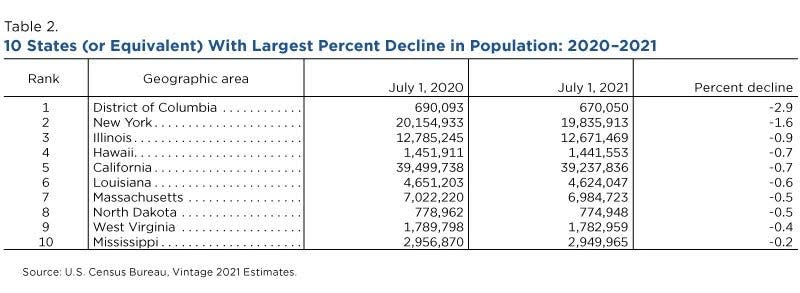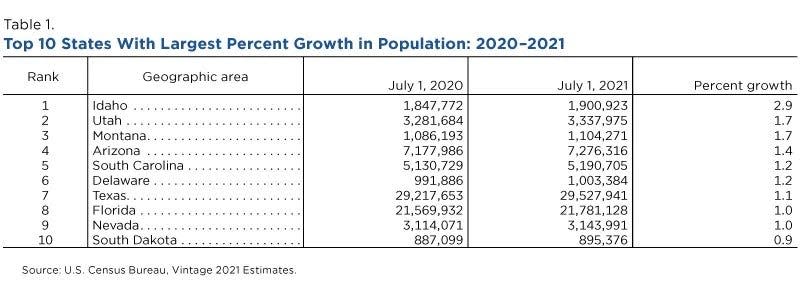US population growth now lowest since nation's founding
Newly released estimates from the U.S. Census Bureau conclude that U.S. population grew at a slower rate in 2021 than in any other year since the nation's founding.
The Census Bureau's Vintage 2021 Population Estimates, released on December 22, show that population grew by 392,665 people, or less than 0.12% of U.S. total population. The year 2021 is the first time since 1937 that the U.S. population grew by fewer than one million people, and the lowest numeric gain in total population since at least 1900, when the Census Bureau first began annual population estimates.
Total U.S. population as of Dec. 1, 2021 was estimated at 331,893,745, making it the third most populated country in the world behind China (1.449 billion), India (1.380 billion), and ahead of Indonesia (274 million) and Pakistan (221 million).
The Census Bureau attributes the historically low population increase to lower international migration, a decrease in birth rates and an increase in mortality due in part to the COVID-19 pandemic. Apart from the last few years, the slowest rate of growth in the 20th century was from 1918-1919 amid the Spanish Influenza pandemic and World War I.
“Population growth has been slowing for years because of lower birth rates and decreasing net international migration, all while mortality rates are rising due to the aging of the nation’s population,” said Kristie Wilder, a demographer in the Population Division at the Census Bureau. “Now, with the impact of the COVID-19 pandemic, this combination has resulted in a historically slow pace of growth.”
International migration patterns both to and from the United States fell dramatically in 2021 due to travel restrictions imposed following the outset of the pandemic. Land borders between the U.S., Mexico and Canada were closed beginning in March 2020 and remained closed for 15-months to all non-essential travel. The U.S. also closed three-fourths of its consulates abroad, which exacerbated the tremendous backlog for issuing new immigration visas and resettling refugees.
According to Census Bureau statistics, between 2020 and 2021 the U.S. added a total of 247,000 people to its population due to foreign immigration; less than a quarter of last decade's high of 1,049,000 set between 2015 and 2016.
As more and more Americans decide to delay pregnancy or to forgo having children altogether, the nation's natural growth rate has gone into decline. "Natural increase", which is the number of births over deaths, was just 148,043 between July 1, 2020, and July 1, 2021. This is the first time that net international migration (the difference between the number of people moving into the country and out of the country) has exceeded natural increase for a given year.
How individual states fared
For statistical purposes the Census Bureau divides the United States into four regions; the Northeast, Midwest, South and West.
The South, with a population of 127,225,329, is the most populous region, encompassing 38.3% of the total national population, and was the only region that had positive net domestic migration (people moving from one area to another within the United States) of 657,682 between 2020 and 2021. The Northeast region is now the least populous of the four with a population of 57,159,838 in 2021, and experienced a population decrease of -365,795 residents due to natural decrease (-31,052) and negative net domestic migration (-389,638).

The West saw a gain in population (35,868) despite losing residents via negative net domestic migration (-144,941). Growth in the West was due to natural increase (143,082) and positive net international migration (38,347).
Between 2020 and 2021, 33 states saw population increases and 17 states and the District of Columbia lost population, 11 of which had losses of over 10,000 people. This is a historically large number of states to lose population in year.
Montana is somewhat unique in that it witnessed the third fastest rate of growth in the nation. A total of 20,046 residents were added to the state's population in 2021, giving Montana a net population growth rate of 1.66%. Nearly all that increase is due to people moving to Montana from other parts of the country. Census Bureau statistics show that there were actually 1,787 more deaths than births in Montana from 2020 to 2021; however 21,483 people moved here from other parts of the country during that same period. A total of 579 foreign immigrants came to Montana between 2020 and 2021.

With a total population of 1,104,271, Montana edged past Rhode Island to become the 43 most populous state in the nation. Rhode Island lost 1,769 residents, dropping its population to 1,095,610.
Idaho had the fastest annual and cumulative population increase, growing by 2.9% (53,151) in the last year, and by 3.4% (61,817) since April 1, 2021. Idaho made modest gains from natural increase (4,398) and net international migration (413); however, the main driver of its fast increase was net domestic migration (48,876).
With a population of 29,527,941 in 2021, Texas had the largest annual and cumulative numeric gain, increasing by 310,288 (1.1%) and 382,436 (1.3%), respectively. While gaining population through net international migration (27,185), the growth in Texas in the last year was primarily due to gains from net domestic migration (170,307) and natural increase (113,845).
New York had the largest population decline, decreasing by 365,336 (1.8%) residents. The largest contributor to New York’s declining population people moving to other locations (-352,185). With the loss, New York dropped below 20 million people, decreasing from 20,154,933 to 19,835,913.
Over the past year, the District of Columbia’s population declined by 2.9%, or 20,043 residents, to a population of 670,050 in 2021. This was the largest annual percent decrease in the nation. The decline in the District of Columbia’s population can be attributed to negative net domestic migration (-23,030), which was large enough to offset gains from natural increase (2,171) and net international migration (1,128).
Three states had populations above 20 million in 2021: California (39,237,836), Texas (29,527,941) and Florida (21,781,128).
This article originally appeared on Great Falls Tribune: United States population growth rate in 2021 lowest in history

